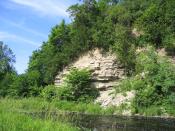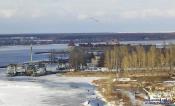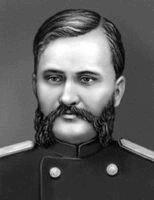Articles
/
Ladoga Canals, the
Ladoga Canals, the
Subject /
Topography/Reservoirs and waterways
LADOGA CANALS. They connect the mouth of the Volkhov River and the head of the Neva, extending along the south coast of Lake Ladoga. There are two canals, Staroladozhsky and Novoladozhsky. The canal construction was urged by the necessity to have a reliable waterway bypassing the difficult-to-traverse Ladoga, where a lot of ships perished (up to one-third of the total number.) Peter I issued the decree of the commencement of the construction on November 18, 1718. To fund the canal construction, a special Empire-wide per household tax was imposed. Free-employed workforce was insufficient, so military units were actively involved in the construction. Initially, G. G. Skornyakov-Pisarev was in charge of the works, and in 1723 he was replaced by Count C. A. Münnich. Peter I personally inspected the construction of the canal in 1723 and 1724. From 1724, the number of the construction workers was increased from 16,000 to 25,000. In 1731, the canal named after Peter the Great was put into operation. It became a part of the Vyshny Volochok canal system constructed by 1709. The canal length was abt. 111 km, its width, over 20 m, and depth, over 2.4 m. The banks were consolidated with fascines, wood, and uncut stone. The canal branched off 4 km away from the Volkhov’s mouth, and canal was connected to the Neva at the distance of 1 km away of the source of the Neva. Special water reservoir were provided between the Kobona and Volkhov rivers, the so-called “reserves” to keep the necessary water level. Near them, and at the points of the canal’s connection to the Neva and Volkhov, locks with floodgates were built. In 1766–1802, the Syas Canal up to the mouth of the Syas River was dug north-west of the Ladoga Canal, and in 1802-10 it was extended up to the mouth of the Svir River, to become a part of the Mariyinskaya canal system. In the 1820–1830s, some of the waterworks (locks and flood gates) were reconstructed. As the old canal became shallow, a new lockless canal was dug closer to the shoreline in 1861-1866, it was named after Emperor Alexander II. It was opened on September 1, 1866. The old canal was called Staroladozhsky, and the new-built one, Novoladozhsky. The new canal took the basic cargo traffic load, using the old one as an auxiliary waterway. The towns of Novaya Ladoga and Schlusselburg are at the ends of L. C. Several rural localities are along the route, of which the most important and ancient are the villages of Dubno, Ligovo, Chornoye, Lednevo, Kobona, Lavrovo. Currently, the Novoladozhsky Canal is used for local shipping, and the Staroladozhsky is gradually deteriorating.
Authors
Yegorov, Sergey Borisovich
Persons
Alexander II, Emperor
Munnich, Christofor Antonovich (Burhard Kristof), Count
Peter I, Emperor
Skornyakov- Pisarev, Grigory Grigoryevich
Geography
Leningrad Oblast, the/Kirovsk District/Chyornoye Village
Leningrad Oblast, the/Volkhov District/Dubno Village
Topographical landmarks/Kobona River, the
Leningrad Oblast, the/Kirovsk District/Kobona Village
Topographical landmarks/Ladoga Lake
Leningrad Oblast, the/Kirovsk District/Lavrovo Village
Leningrad Oblast, the/Kirovsk District/Lednevo Village
Leningrad Oblast, the/Volkhov District/Ligovo Village
Topographical landmarks/Mariyinskaya Canal System
Topographical landmarks/Neva River, the
Leningrad Oblast, the/Volkhov District/Novaya Ladoga Town
Topographical landmarks/Novoladozhsky Canal, the
Leningrad Oblast, the/Shlisselburg Town
Topographical landmarks/Staroladozhsky Canal, the
Topographical landmarks/Svir River, the
Topographical landmarks/Syas Canal, the
Topographical landmarks/Syas River, the
Topographical landmarks/Volkhov River, the
Topographical landmarks/Vyshny Volochok Canal System
Bibliography
Горелов В. Речные каналы в России. Л.-М., 1953
Евгеньев Г. По водным путям Северо-Запада. Л., 1958
Казнаков В. Исторический очерк Ладожских каналов Старого и Нового. СПб., 1873.
Андреева Л.А., Коляда М.И., Кондратьева Е.В. По Ленинградской области. Посвирье, Бокситогорский и Волховский районы. Л., 1978, С. 120-121
Mentioned in articles:
|
hidden
|
Bazaine, Pyotr Petrovich (1786 - 1838), an architect, scientist, teacher
Bazaine, Pyotr Petrovich (1786 - 1838), an engineer-builder, mechanic, mathematician, teacher, Corresponding Member (18170, honorary member of the St. Petersburg Academy of Sciences (1827), Lieutenant-General (1830). He was of France origin. From... more
|
|
|
|
hidden
|
Drainage network
HYDROGRAPHIC NETWORK. Over 19500 rivers and 1800 lakes (Ladoga and Onega being the largest ones) form the H. N. of the Leningrad Oblast. The river network is dense and ramified. One exception is the Izhora Hills where the river network density is... more
|
|
|
|
hidden
|
Industrial architecture
Industrial architecture. Study of structural and functional features of the production constructions in terms of their aesthetic expression started recently. On the material of the Leningrad region of such studies have not yet done. A small number... more
|
|
|
|
hidden
|
Lava River, the
LAVA, a river in Kirovsk District. Length: 51 km. It flows out of the marshes that are situated to the east of the urban settlement of Nazia, and it flows into Lake Ladoga (Petrokrepost Bay.) The toponym is of a Baltic Finnish origin (Finnish.... more
|
|
|
|
hidden
|
Munnich, Christophor Antonovich (Burkhard Christof) (1683-1767), Count, military figure, an architect
Christophor Antonovich (Burkhard Christoph) Munnich (1683-1767), Count (1728), Field-Marshal - General (1732), a statesman and military figure. Munnich was born in Neuenhuntorf, Oldenburg, Denmark. From 1721 he was on the Russian service. C.A.... more
|
|
|
|
hidden
|
Museum of the Shlisselburf Town History, the.
The Museum of the Shlisselburg (Schlusselburg) Town History (Shlisselburg Town, Factory Island, 2a) is a municipal museum and a branch of "The Museum Agency". It was founded on 18 July of 1990. The first exposition was presented in February of... more
|
|
|
|
hidden
|
Novaya Ladoga, town
NOVAYA LADOGA, town in Volkhov District. Population: 10,000. Located in the central part of Leningrad Oblast in the Priladozhskaya Lowland, in the mouth of the Volkhov River, 25 km north of Volkhov Town. Administratively, the town also comprises... more
|
|
|
|
hidden
|
Schlusselburg, town
SCHLÜSSELBURG (Petrokrepost in 1944-92), a town in Kirovsk District. In 1996–2005, a separate municipal entity. Population: 12,400. Located at the head of the Neva River, on its left bank. S. is connected by bus service to Kirovsk and St.... more
|
|
|
|
hidden
|
Skornyakov - Pisarev, Grigory Grigoryevich (1686 - 1747), an architect
Grigory Grigoryevich Skornyakov - Pisarev (1686 - 1747), a military engineer, Major-General (1722). As a scholar of Peter I Grigory Grigoryevich Skornyakov - Pisarev studied mathematics in Berlin. During 1718-1721 he led the construction of the... more
|
|
|
|
hidden
|
Staraya Ladoga, Village
STARAYA LADOGA (Ladoga before 1704), a village in Volkhov District. Population: 2200. Located on the left bank of the Volkhov River where the Ladozhka (Yelena) River flows into it. The toponym is of a Baltic Finnish origin, from Alodejogi (lower... more
|
|
|
|
hidden
|
Zhuravsky, Dmitry Ivanovich (1821-1891), architect
Dmitry Ivanovich Zhuravsky (1821–1891), an engineer, Privy Councillor (1876), a winner of the Demidov Prise (1855). In 1842 he graduated from the Institute of the Railway Engineers Academy. During 1842-50 he took part in pioneering, designing and... more
|
|
|
|
















